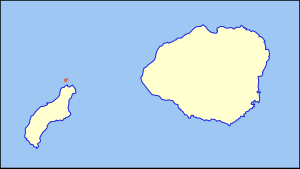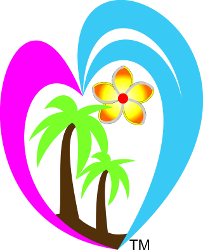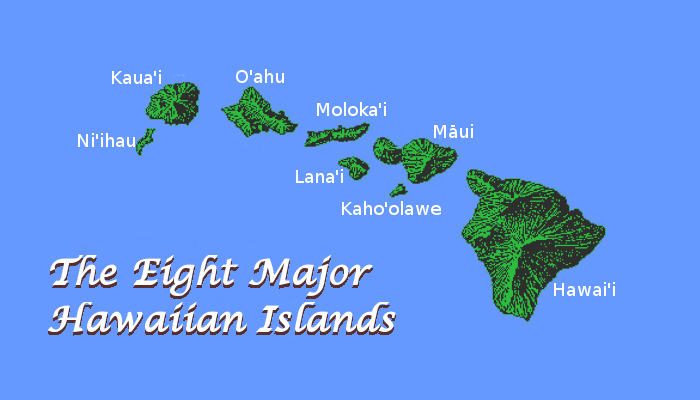| Island | Description |
|---|---|
| For more information from Wikipedia…Click the Island Name | |
| Lehua (lay-who-ah) |
This is a very small and uninhabited island formed by the submerged extinct Ni’ihau volcano tuff cone. It is not spoken of regarding the Eight Major Islands but my family talks story about it. It is the north most landmass in the major island chain. It is .7 miles(1.1km) north of Ni’ihau and 17.5 miles (28.1km) northeast of my island of Kaua’i. On a clear day from the road to Koke’e state park (Koke’e Road) behind our house you can see Lehua laying in the pacific ocean. It is a Hawai’i State Wildlife Sanctuary and is therefore off limits to everyone without a special permit. Like Molokini (below), it is a popular destination for scuba diving and snorkeling as only the landmass is restricted. Lehua was also one of the first 5 islands sighted by Captain Cook.  Location of Lehua Island (the red dot above) shows Lehua in relation to Niʻihau and Kauaʻi. Photos Courtesy Wikipedia |
| Ni’ihau (nee’ ee-how) |
This is the 1st of the 8 major Hawaiian islands in the northeast portion of the chain. It is known as “The Forbidden Isle“. It is in Kaua’i county and is owned by the Robinson family foundation. It is home to about 170 native Hawaiians who live off-the-grid the old Hawaiian way. The island is generally off-limits to all but full native Hawaiians, relatives of the island’s owners (the Robinsons), U.S. Navy personnel, government officials and invited guests, giving it the nickname “The Forbidden Isle”. However anyone may boat, scuba and fish in the surrounding waters. This is where my full blooded Hawaiian great grandma Moha KAIWI-AHU’ULAONALI’I came from.
|
| Kaua’i (Kaw-va’ ee) |
This is the 2nd and oldest public island of the 8 major Hawaiian islands. Its capital city Lihui is the county seat of Kaua’i county. It is known as “The Garden Isle” because it is so lush with foliage and beauty brought by the rains of Mt Waialeale. The top of Kaua’i is Mt. Waialeale which is the 8th wettest place on earth with 9763mm (385 inches) of rain per year. Waialeale means “overflowing water”. In the middle of Waimea where I went to highschool, there is a statue/monument to Captain Cook where he originally landed on my island when he discovered the Hawaiian islands.
|
| O’ahu (oh’ ah-hoo) |
This is the 3rd of the 8 major Hawaiian islands and is known as “The Gathering Place“. It is also it’s own Hawaiian county, Oahu county. It is the home of Pearl Harbor, Punch bowl, the Polynesian Cultural Center, and its biggest and most famous Hawaiian city is Honolulu with the most famous beach in Honolulu, you guessed it Waikiki. It is also home to the Kualoa Ranch (Originally settled by Tahitian chief Laʻa-mai-kahiki and then the Kings Kamehameha’s old ranch and now a movie and TV set) most of which you can visit as a tourist.
|
| Moloka’i (Molo-ka’ ee) |
The 4th of the 8 major Hawaiian islands and is known as “The Friendly Isle“. It is in Māui county. This island is said to have the powers of fertility. It is the 5th largest of the main islands but much of its land is unusable. It is home to Moloka’i ranch of pineapple and cattle. On the north is the Kalaupapa peninsula where you can hike down a steep path, under towing cliffs and find the Kalaupapa National Historic Park of the former leper colony “Kalawao” which was closed in 1969.
|
| Lana’i (La-na’ ee) |
The 5th of the 8 major Hawaiian islands and the 6th largest. It is known as “The Pineapple Isle” and is in Māui county. It has the smallest publicly accessible land of all of the inhabited islands. There is one school serving the entire island from kindergarten to 12th grade. All of its landmarks are only accessible via 4 wheel drive. All roads are dirt and there are no traffic lights on the island.
|
| Māui (Mah-wee) |
The 6th of the 8 major Hawaiian islands and known as “The Valley Isle“. It is the second largest of the Hawaiian islands and is one of the major tourist islands in the chain. Half of Māui’s land is within 5 miles of coastline and of course it is Māui county.
|
| Molokini (Molo-kee-nee) islet |
The Molokini crater is a crescent-shaped, partially submerged volcanic crater which forms a small, uninhabited islet located in Māui County in the Alalakeiki Channel between the islands of Māui and Kahoʻolawe. It has an area of only 23 acres, is .4 miles (.6km) long and is 161 feet(50m) at its tallest point. It is so small it does not normally show up on any satellite photographs. It is a popular tourist attraction for scuba diving and snorkeling and its walls protect divers/swimmers from the very swift current of the Alalakeiki channel. |
| Kaho’olawe (ka-hoe’-o-law-vey) |
This is the 7th and smallest of the 8 major Hawaiian islands. As of 2010 it is uninhabited due to it’s lack of fresh water. It is in Māui county and is only 7 miles southwest of Māui and is only 11 miles long by 6 miles wide. It is known as “The Target Isle” because during WWII it was used by the US Armed forces as a training, bombing and targeting range. |
| Hawai’i (Haw-vy’-ee) |
This is the 8th, last and most southeast island of the Hawaiian island chain. It is the largest of all of the Hawaiian Islands and is bigger than all of the other Hawaiian islands in the archipelago combined. It has the only two remaining dairy farms in the islands. It is the 3rd largest island in all of Polynesia, the two biggest being in New Zealand. It is known as the “Big Island” and has 4 inactive volcano’s Kohala, Mauna Kea, Hualālei, Mauna Loa (which was still the biggest, about 50% of the entire island) and the newest and still very ACTIVE shield volcano, the famous “Kīlauea (kill-low-ay-ah)“. This islands name also names the entire chain of 136 islands that is about 1,500 miles long stretching from this island toward Japan. 7 of the 8 major islands are inhabited and the remaining 129 are uninhabited small islets, atolls and coral reefs. The 8 major Hawaiian islands are the last southeast 300 miles of that chain. |
![]()


 The Eight Major Hawaiian Islands Chain
The Eight Major Hawaiian Islands Chain